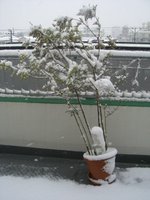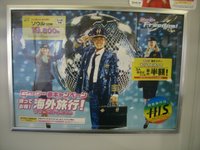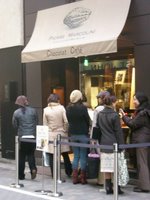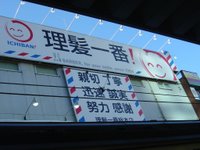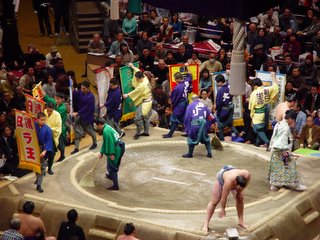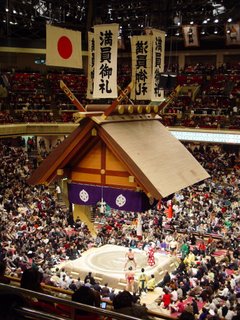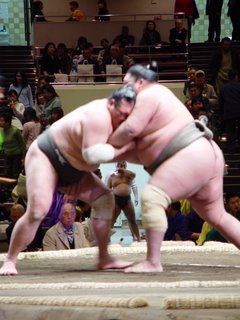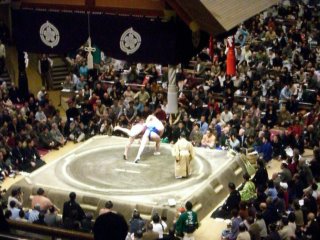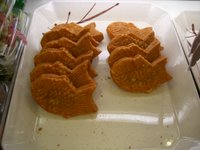Four Degrees Above Zero In Singapore!!
 weater and my hockey jacket! Another definite bonus is that daylight in this part of the world extends to at least 8:30 pm!
weater and my hockey jacket! Another definite bonus is that daylight in this part of the world extends to at least 8:30 pm!Singapore is a Republic of some 4 million people, and is a thriving and prosperous port city that is the gateway to Asia. In my opinion, Singapore is the “third jewel” in the crown of the mystical and romantic seaports on the coast of Continental Asia. The other two are Shanghai and Hong Kong, both of which we have visited previously. What strikes one most forcefully upon arrival is the multi-cultural and multi-ethnic personality of the area: Singapore is truly one of the great crossroads of the world. While some 76% of the population is of Chinese background, there are large local populations of Indonesians, Malaysians, Indians, and Pakistani. This spicy mixture of humanity has been successfully integrated on a solid British backdrop of institutions and customs, and all of this is now being overlaid by a very strong American culture. The result is a heady mixture of all of these ingredients; the like of which I have never encountered in any of my previous travels. At the time that Singapore became a significant trading port and Colony in the 19th century, the orderly and correct British overseers designated specific “quarters” for their emerging trading port, and these ethnic areas still thrive. There is the Chinese Quarter, the Indian Quarter, and the Arab Quarter; each featuring appropriate streetnames, cuisines and buildings. I am not quite sure what the final Quarter is, but it must contain significant portions of British, Australian, New Zealanders, Americans, and some of the many other people from around the globe who flock to the area.
Yes, the locals tell us, Singapore is ‘fine place’, indeed. In fact, they add, there is a fine for urinating in public, a fine for failing to flush a toilet, a fine for picking flowers in a public park, a fine for littering, a fine for spitting in public, a fine for double-parking, a fine for lighting fire-crackers, and until recently, even a fine for chewing gum!
With its heritage of the very British sense of Proper Conduct and respect for orderliness, there are some very harsh laws in effect here in Singapore. A sentence on the Entry Form that must be completed by anyone entering the Republic indicates in bold red letters that the punishment for importing drugs is DEATH. And they mean it, too! Remember, only a few years ago Singapore caned an American who vandalized cars, despite attempts made by President Clinton to intercede in order to avoid corporal punishment, which is offensive to many North Americans. Yet, despite all the diversity and the density of the local population, this beautiful port city is orderly, tranquil and harmonious to the eye of the visitor.
The local food has been truly excellent, which might not be a total a surprize, given the make-up of the population. While it was not unexpected to find some excellent Thai, Chinese and Indian food here, we also had some of the best Mexican Food I have ever eaten, which we thoroughly enjoyed while dining outdoors under the city lights on the banks of the Singapore River at Iguanas Restaurant on the scenic Clarke Quay. Likewise, we enjoyed outstanding, (and auth
 entic) British-Style Fish & Chips at the Fisherman’s Wharf; complete in all details down to the furnishing of Malt Vinegar, chilled mugs of Tetleys Bitter Beer, fresh-made Tartar Sauce, and even authentic Heintz 57 Ketup! Mexican and British foods; truly rare treats in this corner of the world. (Us; enjoying a post-dinner chat with the owner of the Fisherman’s Wharf; Mr. Morten Uttrup).
entic) British-Style Fish & Chips at the Fisherman’s Wharf; complete in all details down to the furnishing of Malt Vinegar, chilled mugs of Tetleys Bitter Beer, fresh-made Tartar Sauce, and even authentic Heintz 57 Ketup! Mexican and British foods; truly rare treats in this corner of the world. (Us; enjoying a post-dinner chat with the owner of the Fisherman’s Wharf; Mr. Morten Uttrup).The local newspaper, the Straits Times, is another gem we have discovered here. It is chuck-full of interesting articles about Indian and Asia, and it has intelligent and articulate articles that inform, educate and provide both analysis and insight into the goings-on in the world. Admittedly, the newspaper concentrates on the local area, but I have found the quality of the writing and breadth and depth of the articles outstanding, in sharp contrast to the very narrow scope of reporting and the shallowness of the articles that appear in most North American papers. However, to most North Americans the residual influence of the British also yields many odd and unexpected expressions contained in the newspaper. Here is a sampling; ‘hard standing’ means ‘parking’; one does not ‘get off’ a vehicle, one ‘alights’; the locals will not know what you want if you ask for a ‘cab’ – a ‘taxi’ is the correct word. You never ‘line-up’ for anything; you ‘Queue’, and a bicycle is a ‘push bike’ to differentiate it from a ‘motor-bike’. To ‘put your front foot forward’ means roughly to ‘go for it’ to us North Americans. The local slang for a fire engine is a ‘Red Rhino’; and when something is ‘thrown out of gear’ it is disrupted.
And, speaking of slang, while English is the universal language here, (although most locals speak a minimum of two languages and often three or four), it appears that there is a certain caché in using English slang in print so as to demonstrate your mastery of the language. At times this practise seems a little excessive; the newspaper is always reporting that something is ‘given the nod’; there is talk that local investors hope to ‘rope in’ a ballooning comp
 any for the tourist trade; a witness at a court case was reported as suffering ‘a bad case of the jitters’, and victory for a visiting team was not ‘on the cards’. (Me; relaxing poolside at Raffles Townclub, Singapore, where we are staying).
any for the tourist trade; a witness at a court case was reported as suffering ‘a bad case of the jitters’, and victory for a visiting team was not ‘on the cards’. (Me; relaxing poolside at Raffles Townclub, Singapore, where we are staying).Local transportation has its high and low points. The subway here is fast, reliable, modern, cheap and entirely comfortable with air-conditioned, roomy coaches that whisk passengers all over the island. Taxis are cheap, but often play ‘hard to get’ when the governing rules can be used to advantage. Waiting for a ride at a Taxi Stand is usually very effective, until it is closing time for the shops, (about 9 pm). We recently waited for a taxi for 1.5 hours, while just behind us cabs eagerly pulled up to the curb for passengers who had either booked a ride in advance or who had cellphones and called the dispatcher for pickup. Likewise, the little snits would scream to a stop to pick up anyone who hailed the cab from the sidewalk. All of these circumstances allow the driver to charge a premium on the normal fare, those patiently waiting at the Taxi Stand were simply being ignored for the moment while the feeding fren
 zy continued. Likewise, we discovered that the drivers will take a ‘Siesta’ around 11:15 in the evening; they are entitled to charge a similar premium after midnight, and the interruption of service guarantees a ready supply of eager customers!
zy continued. Likewise, we discovered that the drivers will take a ‘Siesta’ around 11:15 in the evening; they are entitled to charge a similar premium after midnight, and the interruption of service guarantees a ready supply of eager customers!Cars are very expensive in Singapore; a Toyoto Camry will cost about $85,000 CDN, and that doesn’t include another $35,000 simply to get the government-issued Certificate of Entitlement (COE) that is necessary before you can purchase a car. Small wonder that that the locals refer to the COE as a Certificate of Extortion! At the left: A colourful local taxi hardstanding at the Hilton.
Oh well, even Paradise has the odd rotten fruit! Speaking of fruit, a Pina Colada with my name on it is calling; gotta go!
Doug-San (not currently) in Japan
Saying ‘Buy For Now!’
